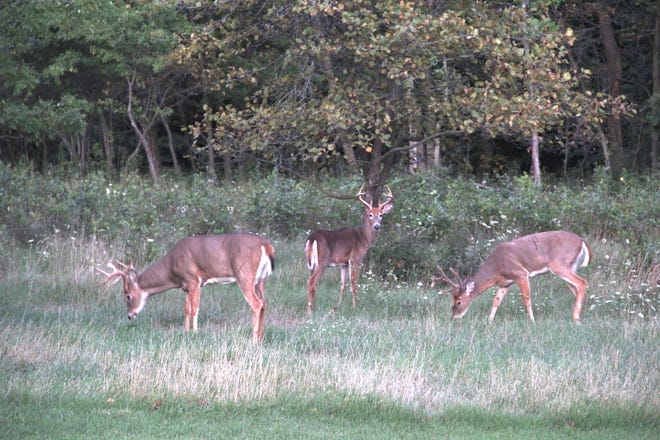[ad_1]
Since it was first identified in 1967 in Colorado, the chronic wasting disease has proven to be a plague on wildlife and agriculture officials.
The deadly deer disease, caused by an infectious prion, or deformed protein, has shown a constant pattern of geographic spread and increasing prevalence.
As of this year, it has been found in at least 26 states, including Wisconsin where it is found in the wild and in herds of captive deer.
But even after 50 years, the system of rules, regulations and enforcement has failed to contain the disease. At least once a month, a new outbreak or discovery of CWD is detected.
And in many states, agriculture and wildlife agencies seem to be working against the grain and having poor collaboration.
On Monday, for example, the Minnesota Department of Natural Resources issued a press release referring to a September 26 Milwaukee Journal Sentinel Article and said the agency learned from the article, not its agriculture officials in the state, that a MDC-positive northern Wisconsin deer farm transferred nearly 400 deer over the course of over the past five years to facilities in seven states, including Minnesota.
“MNR contacted the Minnesota Board of Animal Health (BAH) the same day
(September 27) to verify the authenticity of the report, “the press release read.” The BAH confirmed that two Minnesota deer farms received a total of five deer from the Wisconsin farm between 2016 and 2017. It was not not known if the deer were infected when they were transferred to Minnesota. “
As state and federal agencies continue to fight the disease, a Minnesota-based initiative recently spoke out in favor of a potent medicine that is tackling part of the problem – the captive deer industry.
Following:Agriculture officials grapple with the plight of a CWD positive deer farm in Taylor County
Following:Smith: 20 years with CWD in Wisconsin offers thinking, new habits
The Coalition of Action on CWD says cervid captive operations have been a major vector in the spread of CWD across Minnesota.
“This endangers the health of our wild deer, the hunting traditions of our state and the economy that supports deer hunting,” said Brad Gausman, executive director of the Minnesota Conservation Federation, member and organizer of the coalition. .
Accordingly, the CWD Action Coalition calls on the Minnesota legislature to: buy out the deer farming industry; order a moratorium on any new cervid farm in the state; prohibit the transport of live deer within the state, including to hunting ranches; and enact a ban on the movement of bodily fluids such as urine and semen from deer.
The moratorium on new deer captive facilities would not apply to wildlife research, rehabilitation, reintroduction efforts or zoological facilities accredited by the Association of Zoos and Aquariums.
The coalition published a position statement on CWD and deer farming end of September.
She pleads for compensation to owners of captive cervids for the loss of their herds. He suggests that USDA’s compensation and payment process could serve as a model for compensating operators.
The coalition includes the Minnesota Conservation Federation, Backcountry Hunters and Anglers-Minnesota Chapter, Bluffland Whitetails Association, Fish and Wildlife Legislative Alliance, Fond du Lac Band of Lake Superior Chippewa, Minnesota Chapter of the Wildlife Society, Minnesota Deer Hunters Association, Minnesota Division of Izaak Walton League of America, Minnesota Outdoor Heritage Association,
National Deer Association, National Wildlife Federation and Sportsmen for the Boundary Waters.
The Minnesota Conservation Federation is the state branch of the National Wildlife Federation.
The coalition said wild deer and deer hunting has an annual economic impact of $ 500 million in Minnesota, while, according to a 2017 study, deer farming in the state has had an annual economic impact. of $ 24.2 million.
In addition, according to the USDA model, the coalition estimated that the cost of buying the industry would be $ 24 million.
Minnesota’s initiative seeks to build bipartisan support; no serious effort has yet been made to buy out the state’s deer breeders.
And no similar surge is currently underway in Wisconsin.
“Based on what we’ve seen in the spread between deer farms, we believe these measures are the best way to protect the wild deer herd,†Gausman said.
To see the coalition position statement in MDC and deer farms, visit www.mncf.org.
Change of Sandhill, meeting: Due to the discovery of a chronic wasting disease in Wood County and the potential for the disease to affect public access to Sandhill Wildlife Area, MNR has announced that it will relinquish its game farm license on the 9,150 acre property.
As part of the change, the white-tailed deer herd will be depopulated and the perimeter fence will be removed.
A public meeting will be held Wednesday in Pittsville to discuss MNR’s plans for Sandhill.
The department has held a game farm license for the site since 2003.
According to state regulations, game farms affected by CWD must implement a biosecurity plan that aims to stop the spread of the disease. Although MDC has not yet been found in Sandhill, it has been found in Wood County.
If found on the property, public access would be restricted or prohibited.
The DNR has decided to relinquish its game farm license in order to “safeguard the continued public enjoyment” of the site, the agency said in a press release. A timetable has not been set for the decommissioning process. The MRN also did not specify what means, such as special hunts, liberalized regulations or snipers, it intended to use to remove the deer.
Although it will no longer function as a game farm, other aspects of the property will remain in place in Sandhill, the agency said, including the Outdoor Skills Center, the dormitory, the Trumpeter Trail, the hiking trails and the wildlife refuge and its operation as a demonstration of wildlife. Zoned.
[ad_2]

